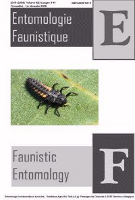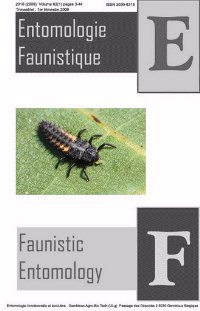- Accueil
- volume 61 (2008)
- numéro 3
- A new species of Aphistina Oldroyd 1972 from Thailand (Diptera: Asilidae: Laphriinae)
Visualisation(s): 1391 (3 ULiège)
Téléchargement(s): 399 (0 ULiège)
A new species of Aphistina Oldroyd 1972 from Thailand (Diptera: Asilidae: Laphriinae)

Notes de la rédaction
Reçu le 22 février 2008, accepté le 31 août 2008
Résumé
Le genre Aphistina Oldroyd, 1972 est signalé pour la première fois de la péninsule indochinoise et une nouvelle espèce A. constanti est décrite de Thaïlande.
Abstract
The genus Aphistina Oldroyd, 1972 is cited for the first time from the Indochinese peninsula and a new species A. constanti is described from Thailand.
1. INTRODUCTION
1This note constitutes an addendum to the study of the Asilidae collected in the Indochinese peninsula and conserved in the collections of the Royal Belgian Institute of Natural Sciences (IRSN Brussels) (Tomasovic 2005a, 2005b, 2006a, 2006b, 2007a, 2007b, 2008).
2The specimens cited here have been collected by Jérôme Constant, Patrick Grootaert and Koen Smets (IRSNB) in the Field Research Station of Na Haeo, 500 km from Bangkok. The district is located in Loei Province situated at the latitude 17°29’ to 17°31’ North and longitude 101°04’ East, just southern of the Huang River (Thai-Laos border). The area is approximately 1019 rais (407.6 acres) in total, comprising 1008 rais (403.2 acres), mostly covered with dense forest. Some areas are submitted to agroforestry. The area consists of a dry tropical forest and the soil is mainly sandy loam.
2. MATERIAL AND METHODS
3External structures were examined using a stereomicroscope (Wild M3B 6-16-40) Drawings were made using a camera lucida. The pictures were realized with a Canon EOS 300D. The male genital parts were examined after soaking in KOH solution. They have been stuck on flakes of plastic and pinned together with the specimen. The identification of the genera and the species was based on Oldroyd (1972, p. 230) and Joseph & Parui works (1983, p. 285).
3. TAXONOMY
4Asilidae
5Subfamily Laphriinae
6Genus Aphistina Oldroyd 1972
7Among Laphriinae, this genus is mainly characterized by the hairy metanotal callosities and the anepisternum with two strong bristles behind wing base.
8The included species are rather small, stoutly built, closely looking like the Atomosini, but without neither the venation peculiarity of crossed veins at the apex of the discal cell nor the sclerotized metasternum. The Aphistina are also unusual among Laphriini in having the anatergite slopes hairy.
9The genus Aphistina includes only two species endemic in the Oriental region (carte 1): (i) A. partita (Walker 1857), the genus' type species, locus typicus: Borneo, archipelago Malays, conserved in National History Museum (London); (ii) L. balabacensis Oldroyd 1972, locus typicus: Balabac, Balabac Islands, Philippines, conserved in Bishop Museum (Honolulu.)
10It can be assumed that the ecology of the species included in Aphistina is like that of the other robber flies of the subfamily Laphriinae. The adults occur in forest areas and the larvae live in dead wood.
11Aphistina constanti Tomasovic sp. nov. (photos 1-2)
12Type material.- Thailand, Loei, Na Haeo.
13Holotype: 1♂, (field res stat), 15-19.v.2003. Day catch. Leg. J. Constant, K. Smeets & P. Grootaert.
14Allotype: 1♀, (field res stat), 15-19.v.2003. Day catch. Leg. J. Constant, K. Smeets & P. Grootaert.
15Paratypes: 1♂ 2♀, Station 20023, 25.v.2000. Leg. P. Grootaert. 4♀, (Bio station), 5-12.v.2001. Secondary forest. Leg. J. Constant & P. Grootaert.
161♂ 1♀, Khring Nam, 12.v.2001. Leg. P. Grootaert. 3♂ 4♀, (field res stat), 15-19.v.2003. Day catch. Leg. J. Constant, K. Smeets & P. Grootaert. 1♂, Firs, 16.v.2003. (23030); 1♂ 2♀, Chang Tok, 17.v.2003. (23035); 2♂, (Malaise trap 4), 22-29.v.2003. Leg. P. Grootaert.
17All material is conserved in the collections of the Royal Belgian Institute of Natural Sciences (RBINS, Brussels).
18Diagnose.- Small dark species with the mystax white, the femora and tibias yellow but this last have the distal part brown like the tarsomeres. The abdomen is dull black with thin lateral marginal bristle mixed with the hairs.
19Description.- Male: length of body 6-9mm.
20Head: Frons and face with greyish tomentum; frons with two short black setae along each eye margin; face with sparse white hairs. Mystax compact, white. Antennae: scape shorter as the pedicel, black with white setae; pedicel pale brown with black setae; postpedicel as long as the combined length of scape and pedicel, dull orange on the lower part and black at upper part. Proboscis and palpi black with white chaetotaxy. Ocellar tubercle with two stout and long black setae. Occiput with whitish tomentum, setae at the side white, two stout long black setae in each upper half.
21Thorax: black; scutum entirely covered with tomentum and fine black hairs mixed with smaller yellowish hairs; bristles: 2 notopleurals, 2 supra-alars, 2 postalars. Scutellum with fine white hairs on disc and 4 scutellar bristles. Pleura with dense greyish tomentum; 2 posterior strong whitish anepistermal bristles. Katatergal bristles fine, long and yellowish.
22Legs with whitish hairs and bristles, femora yellow, tibiae yellow and darker at apex, with very long, conspicuous bristles, tarsomeres brown. Wings iridescent, venation not remarkable.
23Halteres slightly yellowish.
24Abdomen: compact, bright black, pilosity yellow, very thin. 3-5 yellow, thin lateral marginal bristle mixed with thin hairs. Sternites black dull with sparse thin yellow hairs.
25Male genitalia: gonocoxites with thin white hairs, without setae. Aedeagus with three thin tubes. Apical process parallel-sided, slightly curved. Dististylus slender, slightly swelling with a point at the apex (figs. 1-2).
26Female: like the male.
27Etymology.- The species is dedicated to Mr Jérôme Constant (RBINS) for his interest in Entomology.
28Comments: Unusual in Laphriinae, a strong allometry is observed between individuals. This is also observed in the other Aphistina, which can differ in size by ~one third (photo 3).
29Key to the Oriental species of Aphistina
30Legs black, knees and extreme bases of femora orange, abdomen blue-black
balabacensis Oldroyd (Philippines)
31Legs tawny, tarsomeres and tips of the tibia black, abdomen purplish-black
partita (Walker) (Borneo)
32Legs, femora and tibia yellow, tips of tibia and tarsomeres brown, abdomen bright black
constanti sp. n. (Thailand)
33Acknowledgement
34The author’s tribute goes to Dr Patrick Grootaert (curator, RBINS) for loan of specimens and to Paul Limbourg (RBINS) for the pictures.
Bibliographie
Joseph A.N.T. & Parui P. (1983). A review of the Asilidae (Diptera) from the Oriental region. Oriental Insects 17, p. 269-393.
Oldroyd H. (1972). Robber flies (Diptera, Asilidae) of the Philippine Island. Pacific Insects. Departement of Entomology, Bishop Museum, 14(2), p. 201-337.
Tomasovic G. (2005a). New Asilidae (Diptera) from Thailand: Contribution 2. Bulletin de la Société royale belge d’Entomologie 141, p. 163-167.
- (2005b). Genus Nusa Walker, 1851: three new species from Cambodia and notes on the genus (Diptera: Asilidae: Laphriinae). Bulletin de la Société royale belge d’Entomologie 141, p. 168-173.
- (2006a). Etude sur les genres d’Asilidae (Diptères) recensés de 2003 à 2005 sur le site d’Angkor (Cambodge). Belgiam Journal of Entomology 8(1), p. 11-15.
- (2006b). Note on Oriental Asilidae: description of Ancylorhynchus cambodgiensis n. sp. from Cambodia and taxonomic changes (Diptera). Bulletin de la Société royale belge d’Entomologie 142, p. 137-139.
- (2007a). Description of a new species and review of the oriental species in the subfamily Trigonomiminae Enderlein, 1914 (Diptera: Asilidae). Notes fauniques de Gembloux, 60(3), p. 129-132.
Tomasovic G. & K. Smets (2007b). Description of three new species and a first record of Asilidae (Diptera) from Cambodia. Bulletin de la Société royale belge d’Entomologie 143, p. 41-47.
Tomasovic G. & P. Grootaert (2008). Four new species of robber flies (Diptera: Asilidae) from the Oriental Region. Bulletin de la Société royale belge d’Entomologie 144(1-VI), p. 71-78.
Pour citer cet article
A propos de : Guy Tomasovic
Collaborateur scientifique à la Faculté universitaire des Sciences agronomiques, Unité d’Entomologie fonctionnelle et évolutive (Prof. Eric Haubruge). Passage des Déportés 2, B-5030 Gembloux (Belgique).






